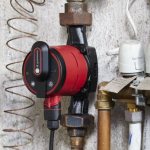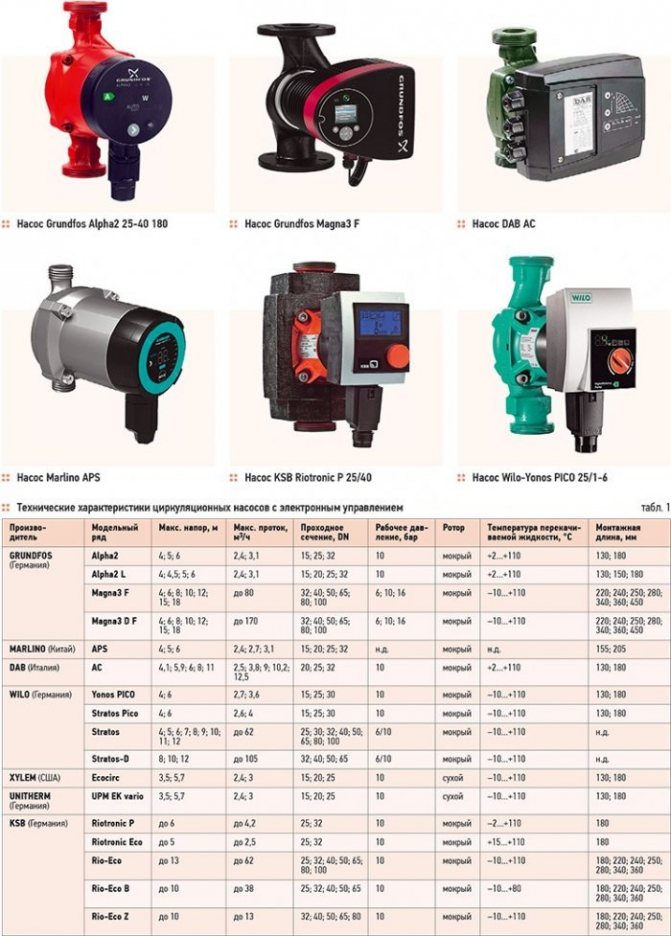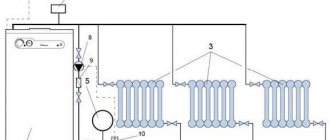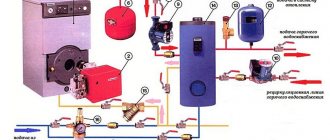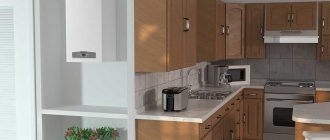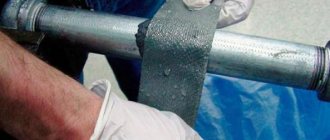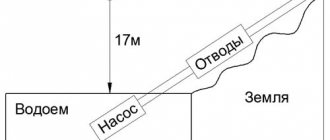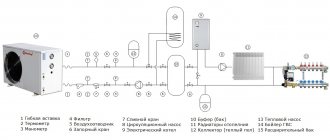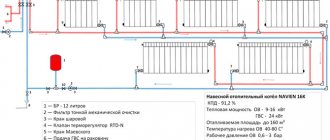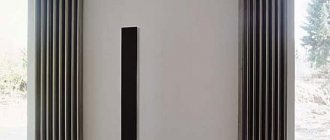Here you will find out:
- What is the calculation of the heating system pump for?
- Selection of a pump according to its main characteristics
- How to calculate the heating circulation pump from the boiler power
- How to choose a circulation pump according to the data obtained
- Empirical pump selection table
- Cavitation in the heating system and in the water supply system
- Pump installation recommendations
The main task of the circulation pump is to improve the circulation of the coolant through the elements of the heating system. The problem of the already cooled water entering the heating radiators is well known to the residents of the upper floors of apartment buildings. Similar situations are associated with the fact that the coolant in such systems moves very slowly and has time to cool down until it reaches the sections of the heating circuit that are at a considerable distance.
When operating autonomous heating systems in country houses, the circulation of water in which is carried out in a natural way, you can also encounter a problem when the radiators installed at the farthest points of the circuit barely heat up. This is also a consequence of insufficient pressure of the coolant and its slow movement through the pipeline. The installation of circulation pumping equipment allows to avoid such situations both in apartment buildings and in private houses. By forcibly creating the required pressure in the pipeline, such pumps provide a high speed of movement of heated water even to the most distant elements of the heating system.
The pump increases the efficiency of the existing heating and allows you to improve the system by adding additional radiators or automation elements
Heating systems with natural circulation of a liquid that transfers thermal energy show their effectiveness when they are used to heat houses of a small area. However, if you equip such systems with a circulation pump, you can not only increase the efficiency of their use, but also save on heating, reducing the amount of energy consumed by the boiler.
By its design, the circulation pump is a motor, the shaft of which transmits rotation to the rotor. A wheel with blades is installed on the rotor - an impeller. Rotating inside the working chamber of the pump, the impeller pushes the heated liquid entering it into the discharge line, forming a coolant flow with the required pressure. Modern models of circulation pumps can operate in several modes, creating different pressures of the coolant moving through them in heating systems. This option allows you to quickly warm up the house at the onset of cold weather by running the pump at maximum power, and then, when a comfortable air temperature is formed in the whole building, switch the device to an economical mode of operation.
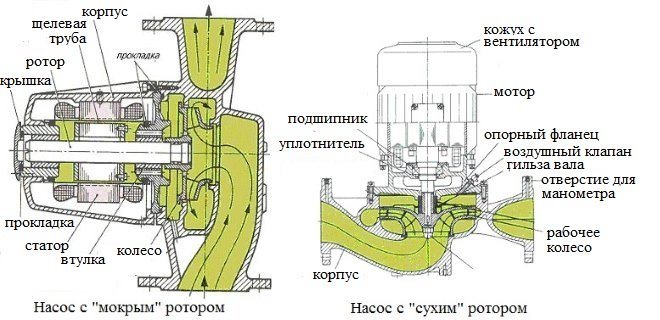
Circulation pump device for heating
All circulation pumps used to equip heating systems are divided into two broad categories: devices with "wet" and "dry" rotor. In pumps of the first type, all rotor elements are constantly in the coolant medium, and in devices with a "dry" rotor, only a part of such elements is in contact with the pumped medium. Pumps with a "dry" rotor differ in greater power and higher efficiency, but they make a lot of noise during operation, which cannot be said about devices with a "wet" rotor, which emit a minimum amount of noise.
What is the calculation of the heating system pump for?
Most modern autonomous heating systems used to maintain a certain temperature in living quarters are equipped with centrifugal pumps that ensure uninterrupted circulation of liquid in the heating circuit.
By increasing the pressure in the system, it is possible to reduce the temperature of the water at the outlet of the heating boiler, thereby reducing the daily consumption of gas consumed by it.
The correct choice of the circulation pump model allows an order of magnitude to increase the level of equipment operation efficiency during the heating season and to provide a comfortable temperature in rooms of any area.
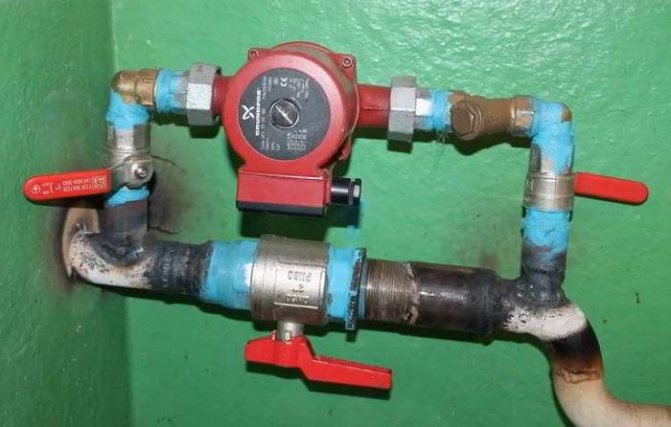

Circulation pump speed control
Pump speeds are the ability of the instrument to vary performance. It is easy to find out about the availability of modes - the description will indicate not one power, but several (usually three).
Read more: How to choose an installation for a toilet: a suspension system, which installation is better, a choice, which one to choose
In the same way, the rotation speed and productivity are indicated in three versions. For example: 70/50/35 W (power), 2200/1900/1450 rpm (rotation speed), head 4/3/2 m.
There are models that automatically change the speed of work (and hence the performance), depending on the ambient temperature.
There is a special switch on the pump body to change the mode. Manual models are advised to set to the maximum power mode and turn it down if necessary. In automatic devices, you just need to remove the regulator from the lock.
The presence of speed modes is not only for increasing comfort. It is also economically justified. Up to 40% of energy can be saved by a mode device versus a conventional one.
Most models of the circulation pump have a function for adjusting the speed of the device. As a rule, these are three-speed devices that allow you to control the amount of heat that is sent to heat the room. In the event of a sharp cold snap, the speed of the device is increased, and when it becomes warmer, it is reduced, while the temperature regime in the rooms remains comfortable for staying in the house.
To change the speed, there is a special lever located on the pump housing. Models of circulation devices with an automatic control system of this parameter depending on the temperature outside the building are in great demand.
To change the speed, there is a special lever located on the pump housing. Models of circulation devices with an automatic control system of this parameter depending on the temperature outside the building are in great demand.
Most models of the circulation pump have a function for adjusting the speed of the device. As a rule, these are three-speed devices that allow you to control the amount of heat that is sent to heat the room. In the event of a sharp cold snap, the speed of the device is increased, and when it becomes warmer, it is reduced, while the temperature regime in the rooms remains comfortable for staying in the house.
Selection of a pump according to its main characteristics
The main technical characteristics of any pump for heating are:
These parameters must ensure sufficient circulation of the coolant for efficient transfer of thermal energy from the boiler to the radiators, therefore they must correspond to both the power of the system itself and the hydraulic resistance in it during the circulation of the coolant. Therefore, in order to make the correct selection of a pump for a heating system, it is necessary to know both of these values.
Their exact calculations, which are used by specialists, are rather cumbersome and complicated.Therefore, with self-selection, you can use simplified calculations using the below simple formulas and recommended average indicators that will allow you to select the optimal characteristics of the circulation pump. Moreover, almost everyone can do such calculations.
Three options for calculating thermal power
Difficulties may arise with the determination of the thermal power indicator (R), therefore it is better to focus on generally accepted standards.
Option 1... In European countries, it is customary to take into account the following indicators:
- 100 W / sq. - for private houses of small area;
- 70 W / sq. M. - for high-rise buildings;
- 30-50 W / sq. - for industrial and well-insulated living quarters.
Option 2... European standards are well suited for regions with mild climates. However, in the northern regions, where there are severe frosts, it is better to focus on the norms of SNiP 2.04.07-86 "Heating networks", which take into account the outside temperature up to -30 degrees Celsius:
- 173-177 W / m2 - for small buildings, the number of storeys of which does not exceed two;
- 97-101 W / m2 - for houses from 3-4 floors.
Option 3... Below is a table by which you can independently determine the required thermal power, taking into account the purpose, degree of wear and tear and thermal insulation of the building.
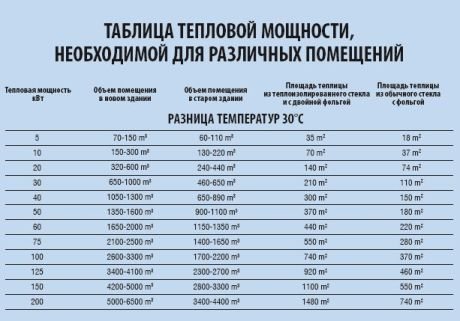

Table: how to determine the required heat output
How to determine the power of the heating system and the required pump flow
The required thermal power of the heating system depends on the amount of heat that is required for comfortable heating of the house and is in direct proportion to its size and the thermal insulation properties of the materials from which its walls, roof, ceiling, floor, windows, doors are made. It is not difficult to calculate the size of a house or part of it heated. A tape measure and a calculator are enough here.
It is more difficult to calculate accurately the heat loss through external structures, since here their material, thickness and design features must be taken into account. Therefore, for a simplified calculation, you can use the recommended average values of 1-1.5 kW of thermal power per 10 m2 of a heated room with a ceiling height of up to 3 m.If the room is well insulated, then you can use a lower value, and if it is not insulated or not enough, then it is better use a larger value.
For example, for a well-insulated house with an area of 120 m2, approximately 12 kW of thermal power will be needed. If the selection of a circulation pump is carried out for an existing natural circulation heating system, then the power of the installed boiler can be taken into account.
Calculation of the required pump capacity
Having decided on the thermal power of heating, you can start calculating the flow (capacity) of the circulation pump. To do this, you can use two simple formulas. The first of them: P = Q / (1.16 x ΔT), (kg / h or l / h) Where:
- Q– previously calculated heating power (W);
- ΔT is the difference between the temperature of the supply pipe and the "return", which for conventional systems, as a rule, is within 20 ° C, and for underfloor heating - about 5 °;
- 1.16 - coefficient taking into account the specific heat of water, W × h / kg × о С (for other coolants (antifreeze, oil) it will be somewhat different and, if necessary, can be found in reference books or on the Internet).
Another formula: P = 3.6 x Q / (s × ΔT), (l / h) Where: s is the heat capacity of the heat carrier (for water 4.2 kJ / kg × ° С). Using any of these formulas, it is possible to determine that, for example, for a two-pipe system with a thermal power of 12 kW, a pump with the following capacity (supply) will be required: P = 12000 / (1.16 × 20) = 517 l / h or 0.5 m3 / h
Calculation of the required head to overcome hydraulic resistance
In order to select a circulation pump for a heating system, in addition to capacity, it is necessary to determine its head (pressure), which it must create in order to overcome the existing hydraulic resistance. But first you need to know the magnitude of this resistance. For a simplified calculation, you can use the formula: J = (F + R × L) / p × g (m) Where:
- L is the length of the pipe line to the most distant radiator (m);
- R is the specific hydraulic resistance of the straight pipe section (Pa / m);
- p is the density of the coolant (for water - 1000 kg / m3);
- F - increase in resistance in connecting and shut-off valves (Pa);
- g - 9.8 m / s 2 (acceleration of gravity).
The exact values of R and F for different pipes, connecting and shut-off valves of different types can be found in the reference literature. For our simplified calculation, you can use the average data of these values obtained experimentally: R - 100-150 Pa / m (the larger the diameter of the pipes and the smoother their inner surface, the less resistance); F can be taken depending on the type of fittings:
- additionally up to 30% of losses in a straight pipe - for each connecting fitting in this section;
- up to 20% - for a three-way mixer or similar devices;
- up to 70% - for the regulator.
You can also use the formula proposed by the specialists of the well-known pump manufacturer Wilo for the calculation: J = R × L × k, m Where: k is the coefficient that takes into account the increase in resistance in the control and shut-off valves:
- 1.3 - simple heating systems with a minimum number of fittings;
- 2.2 - in the presence of control valves;
- 2.6 - for complex systems.
It should be borne in mind that if circulation in a system with two or more wiring circuits (branches) will be provided by only one pump, then their total resistance should be taken into account to select its pressure. If each circuit is provided with a separate pump, then the calculation of the thermal power and resistance of each of them must be performed separately. The number of storeys of a building does not play a big role in calculating the pressure. Because in a closed heating system, the liquid column of the supply line is balanced by the “return” column.
Number of speeds of the circulation pump
Most modern models of circulation pumps are equipped with the ability to adjust the speed of the device. Most often these are three-speed models, with which you can adjust the amount of heat entering the room. So, with a sharp cold snap, the pump speed is increased, and in case of warming, it is reduced so that the air temperature in the rooms remains comfortable for living.
For gear shifting, there is a special lever located on the device body. The models of circulation pumps are very popular, equipped with a system of automatic control of the speed of the device, depending on the change in the outside air temperature.
It should be noted that this is just one of the options for this kind of calculations. Some manufacturers use a slightly different calculation method when selecting a pump. You can ask a qualified specialist to carry out all the calculations, informing him of the details of the device of a specific heating system and describing the conditions for its operation. Typically, the maximum load indicators at which the system will operate are calculated. In real conditions, the load on the equipment will be lower, so you can safely purchase a circulation pump, the characteristics of which are slightly lower than the calculated indicators. The purchase of a more powerful pump is not advisable, as this will lead to unnecessary costs, but the system will not improve the performance.
After all the necessary data has been obtained, the pressure-flow characteristics of each model should be studied, taking into account different operating speeds. These characteristics can be presented in the form of a graph. Below is an example of such a graph, in which the calculated characteristics of the device are also marked.
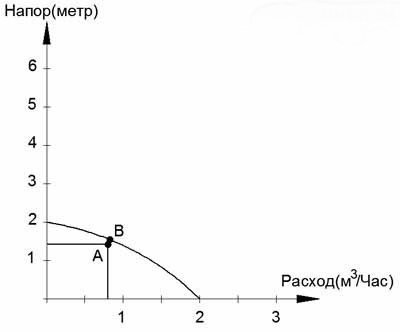

Using this graph, you can select a suitable model of a circulation pump for heating according to the indicators calculated for the system of a particular private house
Point A corresponds to the required indicators, and point B indicates the real data of a specific pump model, as close as possible to theoretical calculations. The smaller the distance between points A and B, the better the pump model is suitable for specific operating conditions.
Pump performance calculations
Productivity (flow) is an indicator of the volume that the unit pumps over in a certain time. For example, liters per minute, liters per hour or cubic meters for the same periods of time.
For calculations, three quantities are needed:
- Supply and return water temperature difference (Δt).
- Boiler power (N);
- The heat capacity of water is the standard value = 1.16.
The coolant temperatures are taken at the outlet from the boiler and at the inlet of the return pipe to the boiler. If it is not possible to make measurements, take an approximate average indicator - this is:
- 20 ° C for a system with radiators;
- 15 ° C if hidden convectors are installed;
- 10 ° C for municipal housing in which the radiators do not overheat;
- 5 ° C for underfloor heating system.
Q = N: (1.16 * Δt)
Let's give an example for a boiler with a power of 8 kW and a temperature difference of 15 ° C.
Q = 8000 (W): (1.16 * 15) = 8000: 17.4 = 460 l / h.
You can convert l / hour into cubic meters simply by dividing the total by 1000. That is, 460 l / h = 0.46 m3 / h. It turns out that a weak circulation pump will be enough for such a system.
You should not take the device either with a margin or with a power shortage. Both work with strain and “half strength” will negatively affect the mechanism.
The performance of this device is usually denoted in the formulas by the letter Q. This value reflects the amount of heat displaced per unit of time.
Q = 0.86R: TF-TR, where
R is the thermal power required to heat the room (kW); TF is the temperature of the heat carrier in the supply pipe of the system (° С); TR is the temperature in the pipeline at the outlet of the system (° С).
Read more: Schemes of ventilation systems in an apartment building implementation options
In European countries, the R indicator depends on the operating conditions, it is customary to calculate it in accordance with the standards:
- in houses where there are no more than two apartments, the power of the circulation pump for heating is taken equal to 100 W / m²;
- in apartment buildings - 70 W / m².
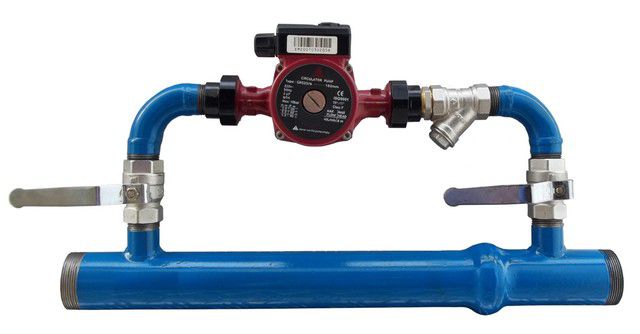

When the pump is calculated for buildings with poor thermal insulation, the value of the above indicators must be increased. If the building is well insulated, use an R value ranging from 30 to 50 W / m².
To calculate the performance of a circulation pump for a heating system in a house, you need to know one of the following parameters:
- a) Heated area of the premises;
- b) Power of the heat source (boiler).
If you know the heated area of all rooms, you first need to calculate the required power of the heat source using the formula.
Q is the required thermal power, kW.
S - heated area of all premises, m2
80 W / m2 - apartment building over 4 floors
100 W / m2 - office building up to 4 floors
120 W / m2 - private house no more than 4 floors
calculation example 90 x 120/1000 = 10.8 kW a boiler is required for a private house of 90 square meters.
Q2 - pump flow rate in m3 / h
Q is the required thermal power, kW.
1.16 - specific heat capacity of water, W.
t1 - temperature of water leaving the boiler in C
t2 - water temperature at the boiler inlet in C
(t1 - t2) is the temperature difference, usually set depending on the type of heating system, for standard radiator systems it is 20 C, underfloor heating 5, other low-temperature systems 10 or 15 degrees.
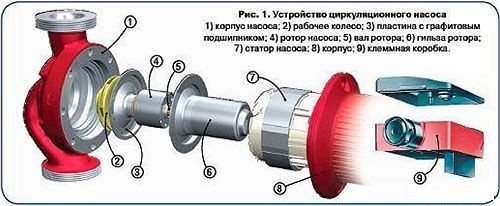

The next step is to calculate and determine the pump head.
The performance of this device is usually denoted in formulas by the letter Q. This value reflects the amount of heat displaced per unit of time.
R is the thermal power required to heat the room (kW); TF is the temperature of the heat carrier in the supply pipe of the system (° С); TR is the temperature in the pipeline at the outlet of the system (° С).
In European countries, the R indicator depends on the operating conditions, it is customary to calculate it in accordance with the standards:
- in houses where there are no more than two apartments, the power of the circulation pump for heating is taken equal to 100 W / m²;
- in apartment buildings - 70 W / m².
When the pump is calculated for buildings with poor thermal insulation, the value of the above indicators must be increased. If the building is well insulated, use an R value ranging from 30 to 50 W / m².
Q = 8000 (W). (1.16 * 15) = 8000.17.4 = 460 l / h.
R is the thermal power required to heat the room (kW); TF is the temperature of the heat carrier in the supply pipe of the system (° С); TR is the temperature in the pipeline at the outlet of the system (° С).
- in houses where there are no more than two apartments, the power of the circulation pump for heating is taken equal to 100 W / m²;
- in apartment buildings - 70 W / m².
Before choosing the desired model of the circulation pump, you should deal with the hydraulic calculation of the system. The value of the pump working capacity is closely related to the heat output of the heating system in question. Consequently, the volume of the coolant pumped by such a unit must provide heat energy to radiators in all rooms. Therefore, calculations will require the value of the thermal power required to heat the premises and the entire building.
As an example, you can use a private house with an area of 100 m2. The heat output will be within 10 kW, respectively. Further, the pump performance is calculated according to the following formula: G = 3600Q / (c∆t), in which G is the required amount of coolant (kg / h), Q is the thermal power of the system (kW), s is the specific heat capacity of water equal to 4.187 kJ / kg ºС, Δt - is the temperature difference in the supply and return pipes.
When choosing a pump, you can notice that in the technical passport, instead of mass flow units, volumetric ones are indicated. In this case, it is necessary to convert the mass of water into its volume using a density of 0.983 t / m3 at t = 60 ° C: 0.43 / 0.983 = 0.44 m3 / h. The resulting value will be the calculated operating performance of the device.
How to calculate the heating circulation pump from the boiler power
It often happens that the boiler was purchased in advance, and the rest of the system elements are selected later, focusing on the power indicators of the heater declared by the manufacturer. Often, a circulation pump is bought to modernize natural circulation heating systems in order to provide the possibility of accelerating the movement of the coolant.
If the power of the boiler is known, use the formula: Q = N / (t2-t1)
Q - pump flow rate in cubic meters / h;
N is the boiler power in W;
t2 - water temperature in degrees Celsius at the outlet from the boiler (inlet to the system);
t1 - on the return line.
Calculation of the hydraulic resistance of the system
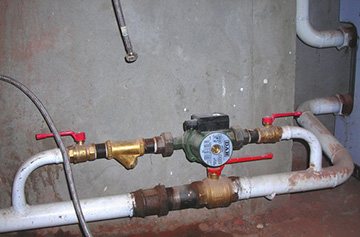

The calculation based on the power of the boiler may not be enough, because the system differs from the system in length, pipe diameter, presence of bends, number of radiators and fittings - and these are all obstacles in the flow path.
Knowing the hydraulic resistance is important in order to find out the required head.
Head - an indicator of how high a given pump can theoretically raise a column of water. Reflects the pump's ability to overcome system resistance.
It is possible to calculate the exact pressure at home only if there is access to technical literature. The exact calculation formula is as follows:
H = (R * L + Z): p * V
- H is the required value (head).
- R - resistance of the straight section (100 - 150 - obtained empirically).
- L is the total length of the pipes.
- Z - tabular data. Resistance of each fitting and armature.
- P is the density of the coolant.
- V is the speed of movement of the coolant.
And for approximate calculations, you only need to measure the total length of the pipes and estimate the number of fittings.
For every 10 m of pipes, 0.6 m of the pump head will be needed (the flow and return are measured, rounded to tens and the resulting indicator is multiplied by 0.6).
The result is added from 20 - 70% (the minimum indicator for simple systems, the maximum - for overloaded fittings).
For reference:
- A three-way mixer takes 20% of the speed;
- Fitting - 30%;
- Thermal relay - 70%.
Owners of private houses do not always have the opportunity to contact a pump repair service center. Do-it-yourself repair of the circulation pump should be mastered by each owner of the unit.
The principle of operation of a natural circulation heating system is described in this topic.
How to choose a circulation pump according to the data obtained
After completing the calculations and determining the main parameters (flow and pressure), we will proceed to the selection of a suitable circulation pump. To do this, we use graphs of their technical characteristics (B), which can be found in the passport or operating instructions. Such a graph should have two axes with the values of head (usually in m) and flow (capacity) in m3 / h, l / h or l / s. On this graph we plot the data obtained during the calculation, in the appropriate dimension and at their intersection we find the point (A). If it is above the pump characteristic curve (A3), then this model does not suit us. If the point falls on the chart (A2) or is below it (A1), then this is a suitable option. But it must be borne in mind that if the point is significantly lower than the graph (A1), then this means that the pump will have an excessive power reserve, which is also impractical, since it will consume more electricity and its cost will also be higher than the model, the characteristic graph which will be as close as possible to our point.
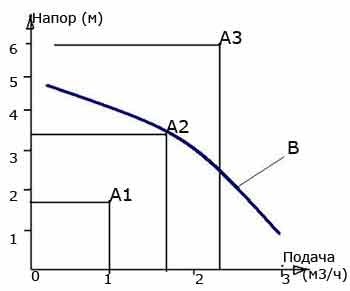

There are models of pumps that have not one, but 2-3 speeds. The graphs of their characteristics will have not one, but, respectively, 2 or 3 lines. In this case, the selection of the pump must be done according to the schedule of the speed that will be used or taking into account all lines if all speeds are used.
Empirical pump selection table
| Heated area (m2) | Productivity (m3 / hour) | Stamps |
| 80 – 240 | 0.5 to 2.5 | 25 – 40 |
| 100 – 265 | Is the same | 32 – 40 |
| 140 – 270 | 0.5 to 2.7 | 25 – 60 |
| 165 – 310 | Is the same | 32 – 60 |
Note: in the third column, the first number is the diameter of the nozzles, the second is the lift height.
Using the given data, you can easily select the right device for stable and long-term operation without much hassle.
Cavitation in the heating system and in the water supply system
Cavitation is a process during which steam molecules are formed in the heating system due to the decrease in pressure. This process takes place if the fluid flow rate decreases or increases in the pipes.
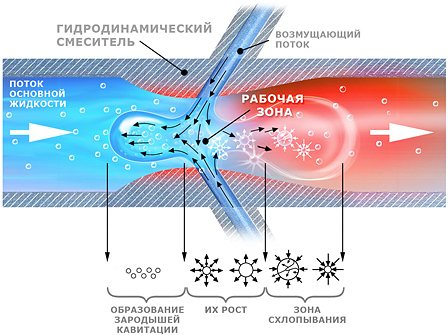

Heating system cavitation
If the heating system is characterized by too low or too high temperatures, then this phenomenon can have a negative effect. The steam that forms collects in bubbles, and if they burst, then, thereby, damage the material from which pipes or other components of the heating system are made.
A correctly selected device and a correctly carried out calculation of the power of the heating circulation pump will guarantee that the operation of the heating system and the water supply system will be most efficient.
If you cannot independently carry out such operations as calculating a pump for heating, or you doubt their correctness, then it is better to entrust this matter to a professional in this field. The specialist will not only help with choosing a pump or making calculations, but will also deal directly with the installation of the pump.
How to choose a DHW circulation pump?
You need to know when choosing that the circulation pump must cope with the following tasks:
- The formation of a pressure in the hot water supply system, which is able to cope with the hydraulic resistance that appears in some elements.
- Providing the required performance and facilitating the movement of heat through the system, which would be sufficient to heat the home.
Based on the goals, the calculation of the circulation pump for the heating system is necessary in order to establish the needs of the house for heat energy and the entire system in hydraulic resistance. If you do not know such parameters, it will be impossible to select the device.
Review the table to know how to choose a circulation pump for heating.
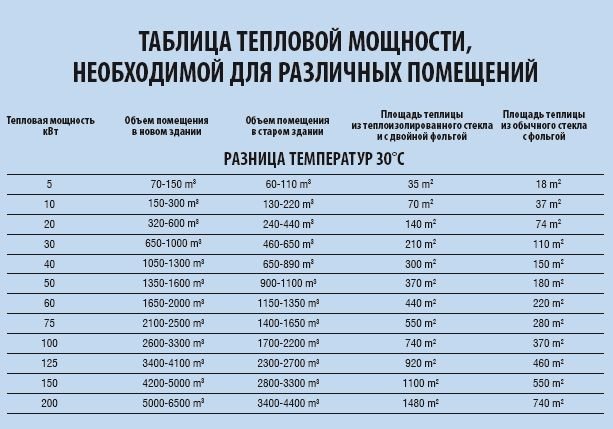

Heat output table for circulation pumps
